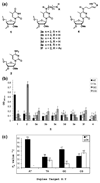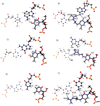Targeting of an interrupted polypurine:polypyrimidine sequence in mammalian cells by a triplex-forming oligonucleotide containing a novel base analogue
- PMID: 20701359
- PMCID: PMC2935506
- DOI: 10.1021/bi100797z
Targeting of an interrupted polypurine:polypyrimidine sequence in mammalian cells by a triplex-forming oligonucleotide containing a novel base analogue
Abstract
The DNA triple helix consists of a third strand of nucleic acid lying in the major groove of an intact DNA duplex. The most stable triplexes form on polypurine:polypyrimidine sequences, and pyrimidine interruptions in the purine strand are destabilizing. Sequence stringency is imparted by specific Hoogsteen hydrogen bonds between third strand bases and the purine bases in the duplex. Appropriate base and sugar modifications of triple helix-forming oligonucleotides (TFOs) confer chromosome targeting activity in living cells. However, broad utilization of TFOs as gene targeting reagents in mammalian cells has been limited by the requirement for homopurine target sequences. Although there have been a number of base analogues described that appear to be promising as candidates for triplex target expansion, none has been examined in a biological system. We have employed a postsynthetic strategy to prepare a collection of TFOs with base analogues at a defined position. Following assessment of affinity for a triplex target with a single C:G inversion, TFOs with a second generation of analogues were synthesized. One of these, TFO-5a, with 2'-OMe-guanidinylethyl-5-methylcytosine at the position corresponding to the C:G interruption in the target sequence, was further modified to confer bioactivity. The activity of this TFO, linked to psoralen, was measured in a mammalian cell line that was engineered by directed sequence conversion to carry a triplex target with a single C:G interruption. TFO-5a was active against this target and inactive against the corresponding target with an uninterrupted polypurine:polypyrimidine sequence.
Figures







Similar articles
-
Targeted cross-linking of the human beta-globin gene in living cells mediated by a triple helix forming oligonucleotide.Biochemistry. 2006 Feb 14;45(6):1970-8. doi: 10.1021/bi0520986. Biochemistry. 2006. PMID: 16460044
-
Synthesis of novel TFOs bearing an abasic portion and their triplex forming ability with a DNA duplex containing a pyrimidine-gapped polypurine strand.Nucleic Acids Res Suppl. 2003;(3):141-2. doi: 10.1093/nass/3.1.141. Nucleic Acids Res Suppl. 2003. PMID: 14510420
-
Purine- and pyrimidine-triple-helix-forming oligonucleotides recognize qualitatively different target sites at the ribosomal DNA locus.RNA. 2018 Mar;24(3):371-380. doi: 10.1261/rna.063800.117. Epub 2017 Dec 8. RNA. 2018. PMID: 29222118 Free PMC article.
-
Triplex DNA structures.Annu Rev Biochem. 1995;64:65-95. doi: 10.1146/annurev.bi.64.070195.000433. Annu Rev Biochem. 1995. PMID: 7574496 Review.
-
The development of bioactive triple helix-forming oligonucleotides.Ann N Y Acad Sci. 2005 Nov;1058:119-27. doi: 10.1196/annals.1359.020. Ann N Y Acad Sci. 2005. PMID: 16394131 Review.
Cited by
-
Insights into the Molecular Structure, Stability, and Biological Significance of Non-Canonical DNA Forms, with a Focus on G-Quadruplexes and i-Motifs.Molecules. 2024 Oct 2;29(19):4683. doi: 10.3390/molecules29194683. Molecules. 2024. PMID: 39407611 Free PMC article. Review.
-
Triple helical DNA in a duplex context and base pair opening.Nucleic Acids Res. 2014 Oct;42(18):11329-38. doi: 10.1093/nar/gku848. Epub 2014 Sep 16. Nucleic Acids Res. 2014. PMID: 25228466 Free PMC article.
-
Synthesis and triplex-forming properties of oligonucleotides capable of recognizing corresponding DNA duplexes containing four base pairs.Nucleic Acids Res. 2015 Jul 13;43(12):5675-86. doi: 10.1093/nar/gkv496. Epub 2015 May 26. Nucleic Acids Res. 2015. PMID: 26013815 Free PMC article.
-
Development and functional evaluation of a psoralen-conjugated nucleoside mimic for triplex-forming oligonucleotides.Commun Chem. 2025 Jan 22;8(1):18. doi: 10.1038/s42004-025-01416-2. Commun Chem. 2025. PMID: 39843926 Free PMC article.
-
The Development of Non-natural Type Nucleoside to Stabilize Triplex DNA Formation against CG and TA Inversion Site.Curr Med Chem. 2024;31(19):2663-2686. doi: 10.2174/0929867330666230512114130. Curr Med Chem. 2024. PMID: 37183460 Review.
References
-
- Thuong NT, Helene C. Sequence specific recognition and modification of double helical DNA by oligonucleotides. Angew. Chem., Int. Ed. 1993;32:666–690.
-
- Hartwig A. Role of magnesium in genomic stability. Mutat. Res. 2001;475:113–121. - PubMed
Publication types
MeSH terms
Substances
Grants and funding
LinkOut - more resources
Full Text Sources
Other Literature Sources

